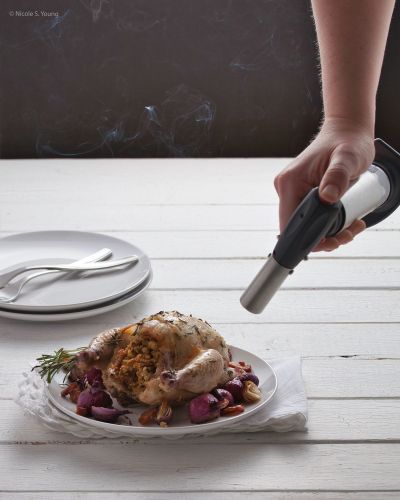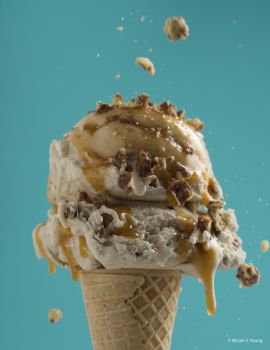
When it comes to food photography, styling the food is something you can’t ignore. Not all foods require extreme amounts of styling, but there are some easy tricks to make food look fresh and delicious. For the most part, my approach to food photography is to have only real food in my photos. Whether you stick exclusively to edible subjects is your call. Just make sure to consider the setup and the purpose of the photo shoot.
All images in this article are created by Nicole Young and post produced using LuminarAI.
What are food and prop styling?
Food styling is the art of making a dish look beautiful. You might wonder what the difference is between a styled dish and an unstyled dish. In the example image below, the photo on the left shows what the dish looks like without styling; the food was cooked and poured into a bowl. On the right, the same dish was prepared in a much more deliberate way, with each item carefully placed in the bowl to make it balanced and full. Each version has its appeal, and even though the “unstyled” version is not highly curated, the food still was put into the bowl with care and photographed to look its best.


Food photographers tend to have their own personal food styling kits based on their preferences. Some items in my kit include a water bottle to spray a fine mist, tweezers, plastic spoons, and small bowls.

Prop styling, on the other hand, involves arranging items such as tablecloths, plates, flatware, and cups. I’ve collected a lot of different types of dishes and other props to use with my food photography so I can create photos that don’t look identical.

When photographing and styling food for commercial purposes, make sure you’re following the proper advertising protocols. If you’re creating food images for a company to use in a campaign, the food you’re photographing needs to be the real thing. For example, if you’re doing a commercial photo shoot for an ice cream brand, you must use real ice cream, not a fake version of it. I’m not a lawyer, though, so I can’t advise you on all the protocols you should follow. It’s important to do your own research when hired to create commercial food photos for a company.
Add leafy greens
Lots of delicious food is orange, red, or brown. These colors can look muddy and overwhelming in a photograph. One way around this is to add a touch of green. In the example below, I was photographing French toast with an orange fruit topping, along with butter and syrup. The food on its own is overwhelmingly orange, so to make it more colorful, I added mint leaves on top as a garnish. The mint suited the cuisine and also made the food brighter and contrasted well with the orange colors in the scene.
Create grill and char marks when food styling meats
If you want to add some extra char or even grill marks to the food you’re photographing, there are a few ways you can do this. A crème brûlée torch allows you to scorch your food, making something crisp or cooking it a little bit more. And by using an electric charcoal starter, you can add grill marks to any food.


Have fun with fake ice cream
If you really want to have some fun, try making fake ice cream! This can be a good prop in any photo shoot — or even by itself. The recipe is simple: combine equal parts canned frosting and powdered sugar in a food processor until the consistency looks similar to ice cream. You can add nuts or food coloring to change it up and make it look like a specific flavor. Add toppings and you’ll have yourself some real-looking fake ice cream to photograph.


Replicate different tabletops
If you’re photographing food in a small space (perhaps in your kitchen), you probably won’t have room for multiple tables. It’s nice to have variety, though. A good way to get it is with vinyl or small sections of material that replicate the look of other surfaces, such as wood or concrete. These don’t take up a lot of space in storage but give you a lot of diversity. I also use pieces of fabric, and sometimes even old scarves or napkins, to create a tablecloth effect.
Food styling tips for working with ice
Ice is a great addition to food photographs. It can make drinks frosty and add condensation to the scene. However, it can be difficult to work with because it melts so quickly. You do have the option of working with real ice, as I did in the photo of mint tea being poured into a glass. But you can also use fake ice. A quick tip: When using fake ice, if you’re putting it in a glass, make sure it rises above the surface of the liquid. Real ice floats (as you can see in the photo on the left), and if you have fake ice that’s sunk to the bottom it won’t look real. I use fake ice in glasses, often without any water, in the backdrop of many of my food photos.



Add bulk to fill the bowl
If you have a large bowl and you don’t want to use up all your food to fill it, you can always add something underneath the food to bulk it up. This tip is a good option if you don’t want items to sink to the bottom of soup, for example. An upside-down smaller bowl usually does a good job and is a great way to make garnishes in soup rise to the surface.

Add steam and heat
I like to have fun with moving elements in my food photography and will sometimes play around with adding steam to a photo. A handheld clothes steamer does a great job, especially when the scene is backlit and the food is photographed against a dark background.

 Steam is also a good way to melt certain foods. This image of bread with a pad of butter on it wouldn’t be the same if the butter weren’t melted slightly, which I accomplished with a hand steamer.
Steam is also a good way to melt certain foods. This image of bread with a pad of butter on it wouldn’t be the same if the butter weren’t melted slightly, which I accomplished with a hand steamer.
Make it messy
For this Food Styling Tip, remember that not all food photos need to be perfect and pristine! Add some intentional mess or crumbs to the scene, as I did here with the sprinkles on top of a birthday cupcake. The sprinkles add an extra element and atmosphere to the photo, giving it more life and making the entire image more festive.
Make it mouth-watering using LuminarAI
Once you have your photos cooked and styled to perfection, LuminarAI will help you boost them to the next level. Some tools that stand out are EnhanceAI to improve the lighting and contrast, the Color tool to remove any color cast, and the StructureAI tool, which helps improve the detail and clarity of an image to make food really pop off the plate.
If you like how LuminarAI can help you level up your food photography, go to www.skylum.com and use the discount code SLRLOUNGE to save $10 on the full purchase price. Then start editing your own shots of tasty dishes with incredible AI tools!












Get Connected!